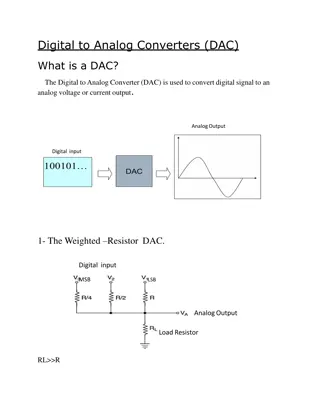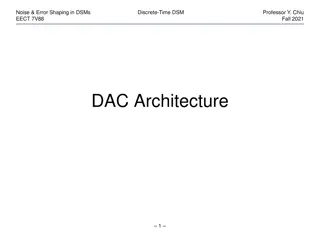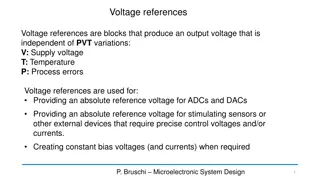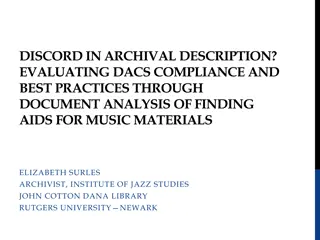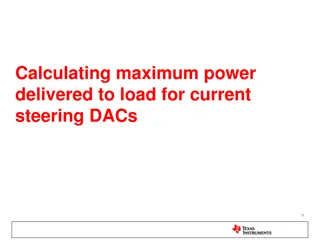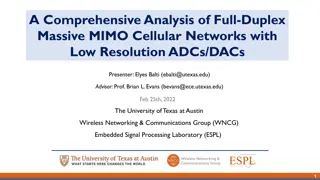Understanding Digital to Analog Converters (DAC) and Their Applications
Digital to Analog Converters (DAC) are essential components used to convert digital signals into analog voltage or current outputs. This article explains the working principle of DACs, provides examples of different types such as Weighted Resistor DAC, R-2R Ladder DAC, Feedback Amplifier DAC, and Si
0 views • 9 slides
Noise & Error Shaping in Discrete-Time DSMs EECT 7V88 - Fall 2021
Explore the intricacies of noise and error shaping in DSMs with Professor Y. Chiu's course on Discrete-Time DSMs for EECT 7V88 in Fall 2021. Delve into DAC architectures including Nyquist, binary-weighted, and more. Learn about Binary-Weighted CR DAC, CP Cu, capacitor arrays, gain errors, nonlineari
1 views • 30 slides
Understanding Band-Gap Voltage References in Microelectronic Systems
Voltage references provide stable output voltages unaffected by variations in supply voltage, temperature, and process errors. This summary delves into the principles of band-gap voltage references and their crucial role in creating precise control voltages for ADCs, DACs, and various other applicat
1 views • 14 slides
High-Speed Serial Link Layout Recommendations for ADCs and DACs
Differential routing is recommended for high-speed JESD ADCs and DACs to improve EMI and crosstalk performance. It's important to keep the distance between differential traces constant, maintain equal lengths for better signal integrity, use bends effectively, and address mismatches between individu
1 views • 18 slides
Evaluating DACS Compliance in Archival Music Collections
This research focuses on evaluating DACS compliance and best practices through document analysis of finding aids for music materials. Elizabeth Surles, an archivist at the Institute of Jazz Studies, explores the challenges in describing music archives and the impact of musical style on documentation
0 views • 21 slides
Calculating Maximum Power Delivery to Load in Current Steering DACs
In the process of calculating the maximum power delivered to the load for current steering DACs, several steps are involved, such as determining the peak-to-peak voltage at the DAC output, converting it to RMS voltage, calculating power delivered to the load, and converting power to dBm. Examples wi
0 views • 5 slides
Overview of Nebraska Statewide Assessment Program
Explore the August 2021 overview of the Statewide Assessment Program in Nebraska. This includes detailed information on the roles and responsibilities of DACs, program resources, objectives, philosophy, parameters, and purpose of the assessment. Learn about the key objectives of the program, its phi
0 views • 50 slides
Comprehensive Analysis of Full-Duplex Massive MIMO Cellular Networks with Low-Resolution ADCs/DACs
Explore the feasibility and advantages of full-duplex massive MIMO technology in cellular networks, focusing on enhancing spectral efficiency, reducing latency, and improving reliability. Discuss challenges such as self-interference and propose solutions like using low-resolution ADCs/DACs. The stud
0 views • 8 slides
High-Speed Serial Link Layout Recommendations for JESD ADCs and DACs
Learn about key layout recommendations for high-speed serial links using JESD ADCs and DACs. Understand the importance of differential vs. single-ended routing, tips for routing and bending differential traces, managing mismatches, and resolving trace length discrepancies with wiggles.
0 views • 11 slides
Criteria Pollutant Analysis for California's Electric Sector Planning
The analysis focuses on minimizing air pollutants and greenhouse gas emissions, with a priority on disadvantaged communities, as directed by California's Public Utilities Commission. It includes quantifying criteria pollutants within and outside of Disadvantaged Communities (DACs) for the years 2026
0 views • 15 slides
